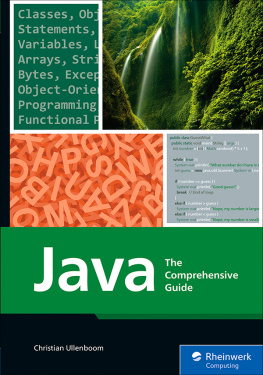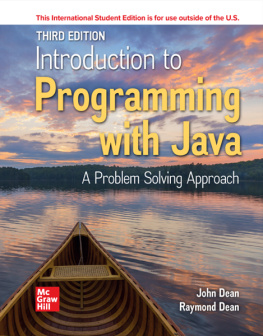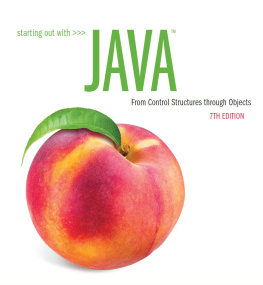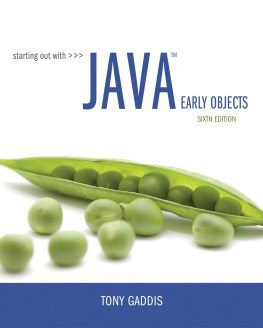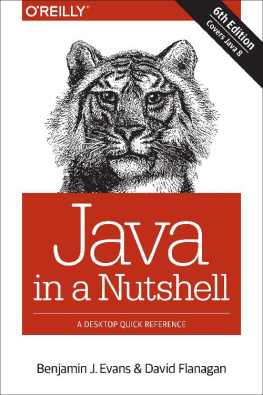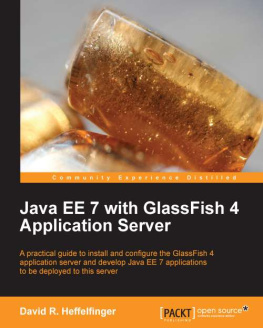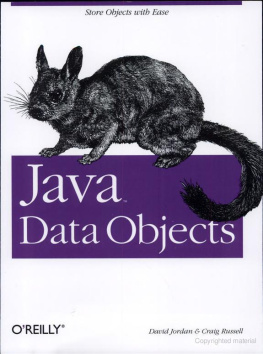Barnes David John - Objects first with Java: a practical introduction using BlueJ
Here you can read online Barnes David John - Objects first with Java: a practical introduction using BlueJ full text of the book (entire story) in english for free. Download pdf and epub, get meaning, cover and reviews about this ebook. City: Vancouver, B.C, year: 2013, publisher: Langara College, genre: Computer. Description of the work, (preface) as well as reviews are available. Best literature library LitArk.com created for fans of good reading and offers a wide selection of genres:
Romance novel
Science fiction
Adventure
Detective
Science
History
Home and family
Prose
Art
Politics
Computer
Non-fiction
Religion
Business
Children
Humor
Choose a favorite category and find really read worthwhile books. Enjoy immersion in the world of imagination, feel the emotions of the characters or learn something new for yourself, make an fascinating discovery.

- Book:Objects first with Java: a practical introduction using BlueJ
- Author:
- Publisher:Langara College
- Genre:
- Year:2013
- City:Vancouver, B.C
- Rating:3 / 5
- Favourites:Add to favourites
- Your mark:
- 60
- 1
- 2
- 3
- 4
- 5
Objects first with Java: a practical introduction using BlueJ: summary, description and annotation
We offer to read an annotation, description, summary or preface (depends on what the author of the book "Objects first with Java: a practical introduction using BlueJ" wrote himself). If you haven't found the necessary information about the book — write in the comments, we will try to find it.
Objects first with Java: a practical introduction using BlueJ — read online for free the complete book (whole text) full work
Below is the text of the book, divided by pages. System saving the place of the last page read, allows you to conveniently read the book "Objects first with Java: a practical introduction using BlueJ" online for free, without having to search again every time where you left off. Put a bookmark, and you can go to the page where you finished reading at any time.
Font size:
Interval:
Bookmark:
 ONLINE ACCESS Thank you for purchasing a new copy of Objects First with Java: A PracticalIntroduction Using BlueJ,Fifth Edition. Your textbook includes six months of prepaid access to the books VideoNotes. This prepaid subscription provides you with full access to the following student support areas: t7JEFoNotes are Pearsons new visual tool designed to teach students key programming concepts and techniques. These short step-by-step videos demonstrate how to solve problems from design through coding. VideoNotes allows for self-paced instruction with easy navigation including the ability to select, play, rewind, fast-forward, and stop within each VideoNote exercise. Use a coin to scratch off the coating and reveal your student access code.Do not use a knife or other sharp object as it may damage the code. To access the VideoNotes for Objects First with Java: A Practical Introduction UsingBlueJ,Fifth Edition, for the first time, you will need to register online using a computer with an Internet connection and a web browser. The process takes just a couple of minutes and only needs to be completed once.
ONLINE ACCESS Thank you for purchasing a new copy of Objects First with Java: A PracticalIntroduction Using BlueJ,Fifth Edition. Your textbook includes six months of prepaid access to the books VideoNotes. This prepaid subscription provides you with full access to the following student support areas: t7JEFoNotes are Pearsons new visual tool designed to teach students key programming concepts and techniques. These short step-by-step videos demonstrate how to solve problems from design through coding. VideoNotes allows for self-paced instruction with easy navigation including the ability to select, play, rewind, fast-forward, and stop within each VideoNote exercise. Use a coin to scratch off the coating and reveal your student access code.Do not use a knife or other sharp object as it may damage the code. To access the VideoNotes for Objects First with Java: A Practical Introduction UsingBlueJ,Fifth Edition, for the first time, you will need to register online using a computer with an Internet connection and a web browser. The process takes just a couple of minutes and only needs to be completed once.
Go to http://www.pearsonhighered.com/barnes_kolling/ Click on VideoNotes. Click on the Register button. On the registration page, enter your student access code* found beneath the scratch-off panel. Do not type the dashes. You can use lower- or uppercase. Follow the on-screen instructions.
If you need help at any time during the online registration process, simply click the Need Help? icon. Once your personal Login Name and Password are confirmed, you can begin using the VideoNotes for Objects First with Java: A Practical Introduction Using BlueJ. To log in after you have registered: You only need to register for VideoNotes once. After that, you can log in any time at http:// www.pearsonhighered.com/barnes_kolling/ by providing your Login Name and Password when prompted. *Important: The access code can only be used once. This subscription is valid for six months upon activation and is not transferable.
If this access code has already been revealed, it may no longer be valid. If this is the case, you can purchase a subscription by going to http://www.pearsonhighered.com/barnes_kolling/ and following the on-screen instructions.  Objects First with Java A Practical Introduction Using BlueJ David J. Barnes and Michael Klling University of Kent Fifth Edition Boston Columbus Indianapolis New York San Francisco Upper Saddle River Amsterdam Cape Town Dubai London Madrid Milan Munich Paris Montreal Toronto Delhi Mexico City Sao Paulo Sydney Hong Kong Seoul Singapore Taipei Tokyo Editorial Director:Marcia HortonEditor in Chief:Michael HirschAcquisitions Editor:Tracy DunkelbergerEditorial Assistant:Chelsea BellDirector of Marketing:Patrice JonesMarketing Manager:Yez AlayanMarketing Coordinator:Kathryn FerrantiMarketing Assistant:Emma SniderDirector of Production:Vince OBrienManaging Editor:Jeff HolcombSenior Production Project Manager:Marilyn LloydManufacturing Buyer:Lisa McDowellArt Director/Cover Designer:Anthony GemmellaroCover Art:Photoshot Holdings Ltd / AlamyMedia Project Manager:John CassarFull-Service Project Management, Composition, and Art:IntegraPrinter/Bindery:Von Hoffman dba R.R. Donnelley/ Jefferson CityCover printer:Lehigh-Phoenix Color/Hagerstown Copyright 2012, 2009, 2006, 2005, 2003 by Pearson Education, Inc publishing as Prentice Hall. All rights reserved.
Objects First with Java A Practical Introduction Using BlueJ David J. Barnes and Michael Klling University of Kent Fifth Edition Boston Columbus Indianapolis New York San Francisco Upper Saddle River Amsterdam Cape Town Dubai London Madrid Milan Munich Paris Montreal Toronto Delhi Mexico City Sao Paulo Sydney Hong Kong Seoul Singapore Taipei Tokyo Editorial Director:Marcia HortonEditor in Chief:Michael HirschAcquisitions Editor:Tracy DunkelbergerEditorial Assistant:Chelsea BellDirector of Marketing:Patrice JonesMarketing Manager:Yez AlayanMarketing Coordinator:Kathryn FerrantiMarketing Assistant:Emma SniderDirector of Production:Vince OBrienManaging Editor:Jeff HolcombSenior Production Project Manager:Marilyn LloydManufacturing Buyer:Lisa McDowellArt Director/Cover Designer:Anthony GemmellaroCover Art:Photoshot Holdings Ltd / AlamyMedia Project Manager:John CassarFull-Service Project Management, Composition, and Art:IntegraPrinter/Bindery:Von Hoffman dba R.R. Donnelley/ Jefferson CityCover printer:Lehigh-Phoenix Color/Hagerstown Copyright 2012, 2009, 2006, 2005, 2003 by Pearson Education, Inc publishing as Prentice Hall. All rights reserved.
Manufactured in the United States of America. This publication is protected by Copyright, and permission should be obtained from the publisher prior to any prohibited reproduction, storage in a retrieval system, or transmission in any form or by any means, electronic, mechanical, photocopying, recording, or likewise. To obtain permission(s) to use material from this work, please submit a written request to Pearson Education, Inc., Permissions Department, One Lake Street, Upper Saddle River, New Jersey 07458, or you may fax your request to 201-236-3290. Many of the designations by manufacturers and sellers to distinguish their products are claimed as trademarks. Where those designations appear in this book, and the publisher was aware of a trademark claim, the designations have been printed in initial caps or all caps. Library of Congress Cataloging-in-Publication Data on file 10 9 8 7 6 5 4 3 2 1 ISBN 10: 0-13-249266-0 ISBN 13: 978-0-13-249266-9 To my wife Helen, thirty years and counting djb To Monica, for everything mkThis page intentionally left blank Contents 2.3.1 Keywords 2.4.1 Fields 2.4.2 Constructors 2.5.1 Choosing variable names 2.1.1 Exploring the behavior of a nave ticket machine vi | Contents 4.4.1 Importing a library class 4.4.2 Diamond notation 4.4.3 Key methods of ArrayList 4.7.1 The effect of removal on numbering 4.7.2 The general utility of numbering with collections 3.8.1 Class NumberDisplay 3.8.2 String concatenation 4.8.1 Summary of the music 3.8.3 The modulo operator organizer 3.8.4 Class ClockDisplay 4.9.1 The for-each loop 4.9.2 Selective processing of a collection 3.11.1 Internal method calls 4.9.3 A limitation of using 3.11.2 External method calls strings 3.11.3 Summary of the 4.9.4 Summary of the clock display for-each loop 4.10.1 The while loop 3.12.1 The mail-system 4.10.2 Iterating with an index example variable 3.12.2 The this keyword 4.10.3 Searching a collection 4.10.4 Some non-collection 3.13.1 Setting breakpoints examples 3.13.2 Single stepping 3.13.3 Stepping into methods 4.12.1 Index access versus iterators 4.12.2 Removing elements Contents | vii 5.4.3 Generating random responses 4.14.1 Getting started with the 5.4.4 Reading documentation project for parameterized 4.14.2 The null keyword classes 4.14.3 The Lot class 4.14.4 The Auction class 4.14.5 Anonymous objects 5.6.1 The concept of a map 4.14.6 Chaining method calls 5.6.2 Using a HashMap 4.14.7 Using collections 5.6.3 Using a map for the TechSupport system 4.16.1 A log-file analyzer 4.16.2 Declaring array variables 4.16.3 Creating array objects 4.16.4 Using array objects 5.10.1 Using javadoc in BlueJ 4.16.5 Analyzing the log file 5.10.2 Elements of class 4.16.6 The for loop documentation 4.16.7 Arrays and the for-each loop 5.11.1 Information hiding 4.16.8 The for loop and iterators 5.11.2 Private methods and public fields 5.12.1 The scribble demo 5.12.2 Code completion 5.12.3 The bouncing-balls demo 5.2.1 Exploring the TechSupport system 5.2.2 Reading the code 5.13.1 The static keyword 5.13.2 Constants 5.3.1 Interfaces versus implementation 5.3.2 Using library-class methods 5.3.3 Checking string equality 5.4.1 The Random class 5.4.2 Random numbers with limited range viii | Contents 6.5.1 The task 7.3.1 Using inspectors 6.5.2 Finding the relevant 7.3.2 Positive versus negative source code testing 6.6.1 Using encapsulation to 7.4.1 Regression testing reduce coupling 7.4.2 Automated testing using JUnit 7.4.3 Recording a test 6.7.1 Responsibilities and 7.4.4 Fixtures coupling 7.7.1 A high-level walkthrough 6.11.1 Cohesion of methods 7.7.2 Checking state with a 6.11.2 Cohesion of classes walkthrough 6.11.3 Cohesion for 7.7.3 Verbal walkthroughs readability 6.11.4 Cohesion for reuse 7.8.1 Turning debugging information on or off 6.12.1 Refactoring and testing 6.12.2 An example of refactoring 6.13.1 Enumerated types 6.13.2 Further decoupling of the command interface 6.15.1 Class methods 6.15.2 The main method 8.1.1 The
Contents 2.3.1 Keywords 2.4.1 Fields 2.4.2 Constructors 2.5.1 Choosing variable names 2.1.1 Exploring the behavior of a nave ticket machine vi | Contents 4.4.1 Importing a library class 4.4.2 Diamond notation 4.4.3 Key methods of ArrayList 4.7.1 The effect of removal on numbering 4.7.2 The general utility of numbering with collections 3.8.1 Class NumberDisplay 3.8.2 String concatenation 4.8.1 Summary of the music 3.8.3 The modulo operator organizer 3.8.4 Class ClockDisplay 4.9.1 The for-each loop 4.9.2 Selective processing of a collection 3.11.1 Internal method calls 4.9.3 A limitation of using 3.11.2 External method calls strings 3.11.3 Summary of the 4.9.4 Summary of the clock display for-each loop 4.10.1 The while loop 3.12.1 The mail-system 4.10.2 Iterating with an index example variable 3.12.2 The this keyword 4.10.3 Searching a collection 4.10.4 Some non-collection 3.13.1 Setting breakpoints examples 3.13.2 Single stepping 3.13.3 Stepping into methods 4.12.1 Index access versus iterators 4.12.2 Removing elements Contents | vii 5.4.3 Generating random responses 4.14.1 Getting started with the 5.4.4 Reading documentation project for parameterized 4.14.2 The null keyword classes 4.14.3 The Lot class 4.14.4 The Auction class 4.14.5 Anonymous objects 5.6.1 The concept of a map 4.14.6 Chaining method calls 5.6.2 Using a HashMap 4.14.7 Using collections 5.6.3 Using a map for the TechSupport system 4.16.1 A log-file analyzer 4.16.2 Declaring array variables 4.16.3 Creating array objects 4.16.4 Using array objects 5.10.1 Using javadoc in BlueJ 4.16.5 Analyzing the log file 5.10.2 Elements of class 4.16.6 The for loop documentation 4.16.7 Arrays and the for-each loop 5.11.1 Information hiding 4.16.8 The for loop and iterators 5.11.2 Private methods and public fields 5.12.1 The scribble demo 5.12.2 Code completion 5.12.3 The bouncing-balls demo 5.2.1 Exploring the TechSupport system 5.2.2 Reading the code 5.13.1 The static keyword 5.13.2 Constants 5.3.1 Interfaces versus implementation 5.3.2 Using library-class methods 5.3.3 Checking string equality 5.4.1 The Random class 5.4.2 Random numbers with limited range viii | Contents 6.5.1 The task 7.3.1 Using inspectors 6.5.2 Finding the relevant 7.3.2 Positive versus negative source code testing 6.6.1 Using encapsulation to 7.4.1 Regression testing reduce coupling 7.4.2 Automated testing using JUnit 7.4.3 Recording a test 6.7.1 Responsibilities and 7.4.4 Fixtures coupling 7.7.1 A high-level walkthrough 6.11.1 Cohesion of methods 7.7.2 Checking state with a 6.11.2 Cohesion of classes walkthrough 6.11.3 Cohesion for 7.7.3 Verbal walkthroughs readability 6.11.4 Cohesion for reuse 7.8.1 Turning debugging information on or off 6.12.1 Refactoring and testing 6.12.2 An example of refactoring 6.13.1 Enumerated types 6.13.2 Further decoupling of the command interface 6.15.1 Class methods 6.15.2 The main method 8.1.1 The
Font size:
Interval:
Bookmark:
Similar books «Objects first with Java: a practical introduction using BlueJ»
Look at similar books to Objects first with Java: a practical introduction using BlueJ. We have selected literature similar in name and meaning in the hope of providing readers with more options to find new, interesting, not yet read works.
Discussion, reviews of the book Objects first with Java: a practical introduction using BlueJ and just readers' own opinions. Leave your comments, write what you think about the work, its meaning or the main characters. Specify what exactly you liked and what you didn't like, and why you think so.

